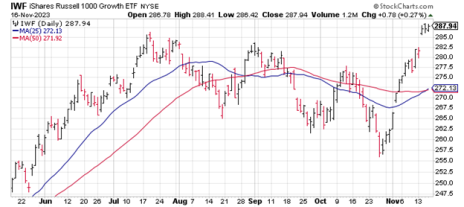After what has felt like an eternity for many investors, the U.S. equity market (and growth stocks in particular) is finally showing signs that strength is returning.
Heralding the latest running of the bulls was the Consumer Price Index (CPI) for October, which revealed a flat reading on headline inflation as energy prices declined almost 3% for the month (offsetting a 0.3% food price increase). The news set off a powder keg-type rally in the indexes last week, with the S&P 500 now close to exiting correction territory.
With inflation showing signs of cooling off, a growing number of analysts now believe the Federal Reserve will stop hiking interest rates—and possibly even lower them—in the coming months. Consequently, the bulls may have finally gained the imperative they need to regain full control of the intermediate-term market trend from the bears.
[text_ad]
Additional confirmation that the bulls are close to achieving full control of the market was seen on November 14, when advancing stocks outpaced declining stocks on the NYSE on a 10-to-1 basis. This reflects a big improvement in market breadth, a fact pointed out by the well-known market technician Dan Sullivan, who observed the last time this happened was on March 24, 2020.
“It is interesting to note,” he wrote, “that the benchmark S&P 500 gained 32% over the following six months” the last time this signal was seen in 2020. Sullivan added that while this scenario doesn’t always mean the market has huge upside potential ahead, “unusually strong breadth readings frequently occurred in the early stages of extended rallies.”
And while advancing-to-declining volume on the Big Board didn’t quite reach the fabled “Volume Blast-Off” signal many participants are looking for (i.e. 10-to-1 up/down volume in a single session), the November 15 up/down volume ratio of 9-to-1 was remarkably close. It was also the single best volume ratio of the year to date and adds some additional credence to the bullish case for equities going forward.
Another consideration for investors looking for evidence the market environment has markedly improved is provided by the three major Dow indexes. The famed mutual fund timer Dick Fabian had a set of rules that some analysts use to this day to time market bottoms, which he set forth in his best-seller, The Mutual Fund Wealth Builder.
Fabian’s rules for identifying when a market bottom is in place are simple. He advocated buying stocks when the Dow Industrials close 2% above the lowest point of the market’s lowest level after a big decline, and the Dow Transports are 4% above the lowest point of the decline and the Dow Utilities are 8% above the lowest point of the decline.
While this system isn’t always pinpoint precise in timing final lows, most bottoms meeting all three prerequisites in recent years have tended to be both confirmed and followed by a multi-month broad recovery. Assuming this one holds true to form, there should be plenty of opportunities ahead for investors as we head into what Stock Trader’s Almanac calls the “Best Six Months” of the year.
In a situation when stocks are coming out of a correction, it normally pays to focus on segments of the market that have outperformed the benchmark S&P 500 during the correction period. This relative performance strength usually denotes the presence of “smart money” investors who are taking positions on what they believe will be the strongest stocks during the market’s next bull phase. (It is, after all, the big-money institutional crowd—and not the easily spooked small investor—that typically buys stocks when the market is making a low).
That said, one of the best-performing market segments right now is growth stocks. The benchmark Russell 1000 Growth Index is one of the few indexes that has managed to make a new high for the year already. And while not all growth areas are acting well (particularly retail and healthcare), there’s enough evidence to suggest that growth stocks in the aggregate will retain a leadership position heading into 2024.
Along those lines, Cabot’s Top Ten Trader Chief Analyst Mike Cintolo recently observed that “leading and potentially leading growth stocks have acted well, with a few moving straight up during the past couple of weeks—possibly an early ‘thrust’ that should portend good things down the road.”
If you’re optimistic that the bulls will continue to build on their recent gains going forward, you could simply buy and hold a growth-focused ETF like the iShares Russell 1000 Growth ETF (IWF). Or you could take a more hands-on approach by taking advantage of the excellent recommendations that Mike offers in each week’s Top Ten Trader.
Mike has been on an impressive run as of late and the weekly report has been filled with some of the market’s best-performing growth stocks in what has been, for the most part, a challenging environment.
And if the bull completely resumes in the coming weeks and months as we expect, growth stocks—which are nearly always one of any bull market’s top performers—will be one area you’ll definitely want some exposure to.
[author_ad]


